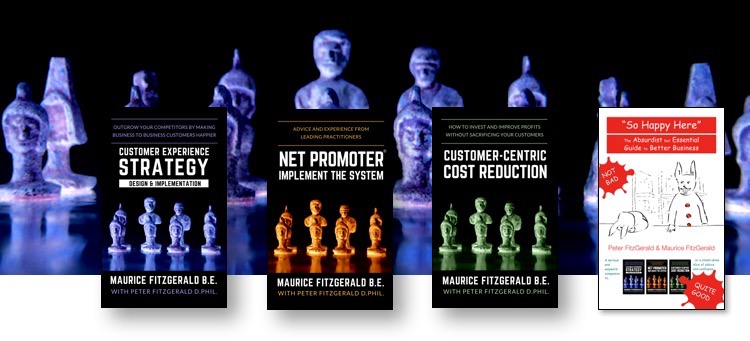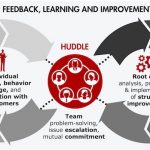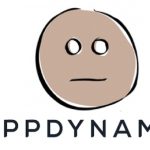#102 – Using AI to predict customer loyalty – A useful NPS benchmark provider quality check
 Welcome to the 102nd Customer Strategy newsletter. The five topics this week are:
A different approach to the use of AI: Early detection of customer disloyaltyI recently had the privilege of meeting Ilkka Huotelin, founder of Be Customer Smart. (Yes, the red color is deliberate.) He talked me through their fascinating approach to the use of Artificial Intelligence to do several important things that it would be difficult to do well another way.
Ilkka’s core personal area of expertise is in telecommunications, though he and his colleagues have covered quite a broad range of industries. One of the most interesting things he showed me was how their software could analyze changes in mobile phone customer behavior and identify which ones predicted that a customer was likely to switch to another vendor at contract renewal time. Understanding this allows telcos to be proactive, intervening before contract renewal time to try to retain the customer. The use of AI means there is no preconceived notion about which customer behaviors matter, and the model is constantly improving to reflect actual customer actions. As many of you know, the main area of AI that has interested me up to now is Natural Language Processing. Ilkka’s approach adds a new dimension. If you want to learn more, go to his website at http://www.becustomersmart.com/. Note in passing that I have no financial relationship whatsoever with Ilkka or his company. I simply like what they do. A useful quality check if you use double-blind NPS benchmarksI spoke to the customer experience leader of an LA-based company a few days ago. (Let’s call him Ludwig for the sake of this article and for his love of classical music.) They had just received their first full set of double-blind NPS benchmarks, covering their company and their four main competitors. Ludwig was justifiably proud of the achievement. I found the way Ludwig and the vendor had compared the open text responses to the ‘Why?’ and ‘What could company X do better?’ questions particularly compelling. It certainly showed where each company’s strengths and weaknesses lay. I was surprised by how different improvement suggestions were for each company covered. The journey to this result was far from painless. Some of this was because the vendor is quite new and had not worked in Ludwig’s industry before. However, the core issue is one that you are extremely likely to come across whenever you use double-blind benchmarking: the companies that provide the service contract in turn with companies that provide panels of representative customers for the relevant industry. Unfortunately, and I base this on my personal experience at HP while IPSOS was the overall service provider, the quality of the panels can be poor. The issue arises when the benchmark vendor does not do a good enough job in checking the quality of the responses given by panel members. Ludwig and the new vendor found these issues after they provided the initial research results. The vendor had not noticed the problems. Note that panel members are paid, either in cash or with some sort of cash equivalent. If a respondent answers for more than one company, they make more money. This gives rise to fraud. The main areas of cheating I saw and that Ludwig also saw were:
I could easily give you a much longer list but I find these three items the most obvious. If you are considering benchmark NPS providers or indeed already use such services, I would encourage you to do this basic level of inspection yourselves.
Our latest blog postsThe posts on this list are part of my extensive and deep series about the Net Promoter System. Older posts are still available on the blog page.
Notable customer experience items from other sitesWillie Pietersen – Why Strategy is in TroubleReaders who have read Customer Experience Strategy – Design and Implementation know that I consider Willie Pietersen to be the greatest business strategist alive. I learned almost all of what I know about developing a clear and implementable business strategy when attending the Creating Breakthrough Strategy course at Columbia business school. Willie has been the CEO of several large companies. I believe this is what made him develop a particularly simple approach that is easy to communicate. Willie has a blog, but only seems to post a few articles each year. His latest article provides a simple summary of his thinking, as expressed in his courses and books. I strongly believe that even this short read can help anyone working on strategy to avoid what he calls the “fog of complexity and confusion” that surrounds most companies’ strategy development process. Read all about it here. XM Institute free research downloadsThe Temkin Group was acquired by Qualtrics and rebranded as the XM Institute. (XM stands for Experience Management.) They decided to make most research free of charge. Some readers know that I was able to get a free copy of their 2018 NPS benchmarks; a really useful document. However, their site has no search functionality and it is hard to find what you want. The link below is to the main research page. Even I can no longer find the file I downloaded. If you know how to search this site properly, please let me know. This is not to detract from the excellent content that is easy to find. Have a look here. Looking forwardBook sales are doing surprisingly well, so thank you. June was the best of the three Junes since the books first appeared. July was the best July. And if August keeps on going the way it has in the first half of the month, it will be our record sales month overall, a surprise during the main European vacation month. I have to say that I don’t know why this is happening. While the rather attractive NPS series could be an explanation, our strategy book is slightly outselling our NPS book. Insights welcome. Here are links to all of our books on Amazon.com. Kindle versions are available in all stores. Print versions are available from the major stores only. And as of two weeks ago, you can find the books, or at least order them in many bookstores. If you have already read any of our books, please write reviews on Amazon. Customer Experience Strategy – Design & Implementation Net Promoter – Implement the System Customer-centric Cost Reduction “So Happy Here”: The Absurdist but Essential Guide to Better Business (Color edition) “So Happy Here”: The Absurdist but Essential Guide to Better Business (Black & White edition) Please share this newsletter with your friends and colleagues and encourage them to sign up for it here. I have put links to past newsletters on the subscription page. Finally, please feel free to change or cancel your subscription using the link below. You can also email me, Maurice FitzGerald, at mfg@customerstrategy.net. |
||||||||||||
|
|









